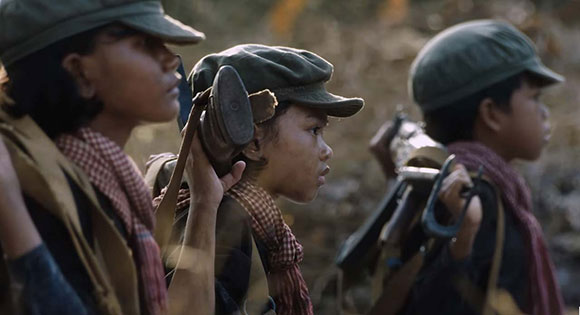STATES OF NEWNESS
Childhood and Aspirational Democracy in Cambodia-U.S. Films
Excerpt

Abstract
This essay traces the figuration of the child in Cambodian postwar films, particularly Cambodia/U.S. co-productions, as an innocuous exemplar of Western liberal ideology against legacies of violence, refuge, and communist anxieties. The Girl Who Spelled Freedom (1986) and Karmalink (2021) span genres, locales, and time periods: from biographical dramatization to spiritual sci-fi; the American South to techno-orientalist Phnom Penh; Cold War nationalist past to imagined Buddhist-cyberpunk future. Despite these contrasting sets and storylines, the child protagonist persists as a universal logic for moral essentialism, unlocked potential, and articulating national identities. By anchoring this analysis with thematic correlation to First They Killed My Father (2017), I argue that these entertainment films created for broad, “family-friendly” appeal politically reconfigure the enduring image of the Cambodian child by placating absence and nothingness with the alluring newness of freedom, progress, and technology. I posit that the mobility of the Cambodian child in these films is a corpus for visualizing embodied transnational belonging (adoption, assimilation, and naturalization) that reaffirms Western neoliberal democracy’s cyclical right to salvage bodies from the detritus of war.
1 Introduction
“The child sees everything in a state of newness.”
– Charles Baudelaire
– Charles Baudelaire
The recurring presence of the child across Cambodian[1] cinema, post-Khmer Rouge, draws focus to their didactic modality as future-oriented embodiments of overcoming tragic loss, abject poverty, and political and social turmoil. Often deploying the innocuous coming-of-age convention, the figure of the child serves to accommodate a specific linearity of time and space—as our preconceived understanding of childhood development follows a fixed sequence of aging, mobility, and transformation. Queer literary scholar Kathryn Bond Stockton, whose provocations resist against a singular conception of ‘growing up’, and whose text I will later return to, asserts, “that ‘the child’ is often defined as a point in time.”[2] These films, contextualized in the aftermath of the Cambodian genocide and produced near the end of the Cold War (1985–1991), intricately reflect on the collective afterwardsness[3] of intergenerational Cambodian genocide survivors and their inherited subjectivities (many of whom experienced war as children themselves). Early critically-acclaimed film[4] such as The Killing Fields (1984) and Rice People (1994) sought to immediately lay bare these atrocities as a retroactive cinematic framework, viscerally reckoning with the lingering consequences of war. Thus, the history of Cambodian modern cinema[5] and mainstream cinematic expression is inextricably intertwined with a malleable temporality—going back and forth between past, present, and future. It is through the embodied nature of the child figure—often depicted as poor, forsaken, and orphaned—across mainstream Cambodian films that most compelled me to further investigate their cinematic figuration as I believe them to occupy transgressive sites of witness, memory, history, and karmic retribution. It is only through modes of childhood subjectivity that adults reimagine futures while also transformatively embodying new cultural hybridities.
In foregrounding two lesser-examined films The Girl Who Spelled Freedom (1986) and Karmalink (2021), I argue that these dramatizations across the contemporary ‘post-war’[6] period not only teaches us about how war is retold and re-imagined through childhood, but how the figure of the child has endured as a transnational symbol of otherness; tracing back to the Cold War past, and recursively desiring to belong within a Western neoliberal futurity. By anchoring these two films with the more widely known and popular First They Killed My Father (2017), we can begin to elucidate how they inform one another and influence modern tropes in Cambodian cinema and popular media at large—specifically our collective imagining of the child orphan, the child soldier, the child adoptee who learns to be exceptional[7], and the child laborer. [I will address how they are similar/different/and why it is important to contextualize them vis-a-vis through a Hollywood mainstream film… they teach us something new that is overlooked in Cambodian cinema *reinforce thesis here*]

2 ‘Loss of Innocence’ Demarcated by Absence/Death of Father
Most ostensibly is the absence and/or violent death of the biological father as a demarcation of the ‘loss of innocence’ at the moment in which the patriarch exits frame, and the child is tasked with reconceptualizing their sense of agency and dependency (though, peculiarly, all of these films envisage similar kinship structures through a genealogy of mothers, grandmothers, and sisters who continue to collectively care for the child). Another discernible similarity is that all of the lead characters are in their own ways ‘real’ children—in The Girl Who Spelled Freedom and First They Killed My Father, child actors Jade Chinn and Sreymoch Sareum, respectively, play younger versions of Linn Yann-Carroll and Loung Ung; while the two lead actors in Karmalink, Leng Heng Prak and Srey Leak Chhith, play fictionalized versions of themselves
Author
Sopheak Sam
KeywordsCambodian, film, national identity, childhood, queer theory
Sopheak Sam
KeywordsCambodian, film, national identity, childhood, queer theory